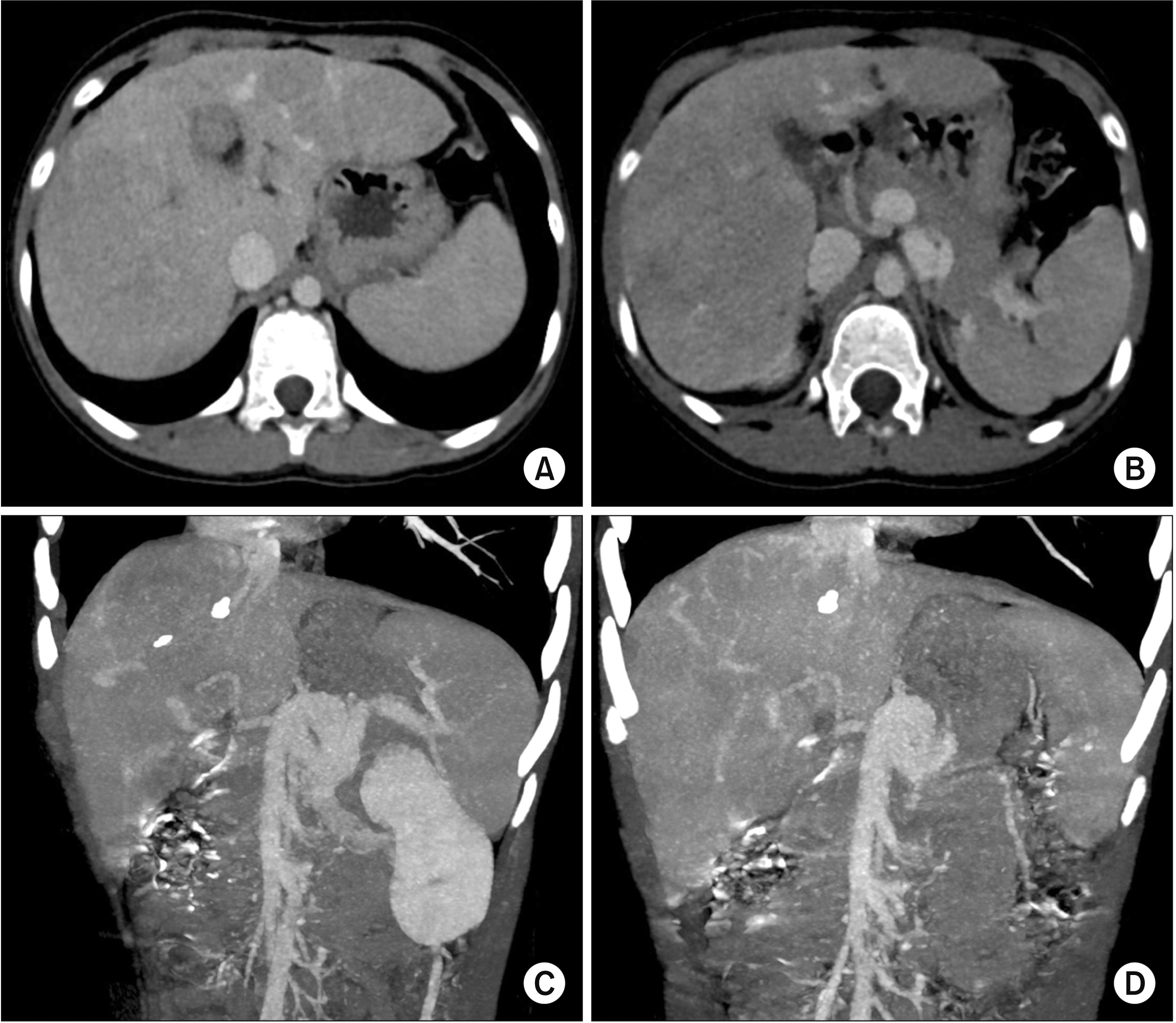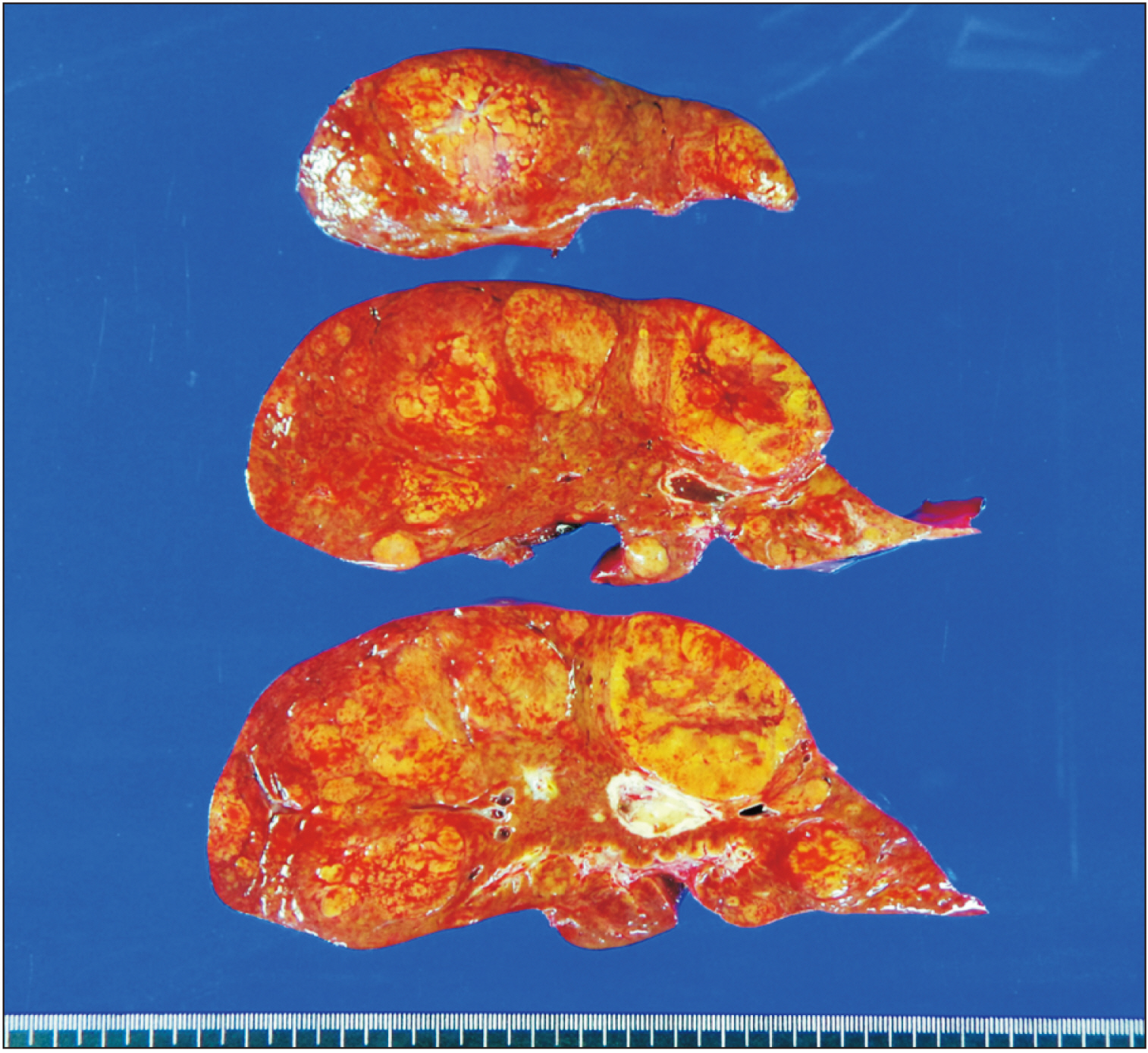Living donor liver transplantation in a pediatric patient with congenital absence of the portal vein
- Affiliations
-
- 1Department of Surgery, Asan Medical Center, University of Ulsan College of Medicine, Seoul, Korea
- 2Department of Pediatrics, Asan Medical Center, University of Ulsan College of Medicine, Seoul, Korea
- KMID: 2519299
- DOI: http://doi.org/10.14701/ahbps.2021.25.3.401
Abstract
- Congenital absence of the portal vein (CAPV) is a rare venous malformation in which mesenteric venous blood drains directly into the systemic circulation. We report a case of pediatric living donor liver transplantation (LDLT) for CAPV combined with focal nodular hyperplasia (FNH) and hepatocellular adenoma. A 9-year-old girl who had been diagnosed with multiple FNH had CAPV. Her blood ammonia level was raised to 137 µg/dL. However, she did not complain of any symptoms. To treat CAPV and FNH, we decided to perform LDLT. The graft was a left liver graft from 39-year-old mother of the patient. Recipient hepatectomy was performed according to standard procedures of pediatric LDLT. Portal vein reconstruction was performed using interposition of an iliac vein homograft conduit to the superior mesenteric vein-splenic vein conf luence. The CAPV-associated congenital splenorenal shunt was securely ligated. The pathology report of the explant liver showed a 2 cm-sized hepatocellular adenoma and multiple FNH lesions measuring up to 7.1 cm. The patient recovered uneventfully from the LDLT operation. The reconstructed portal vein was maintained well without any hemodynamic abnormalities. In conclusion, as CAPV patients can have various vascular anomalies, combined vascular anomalies should be thoroughly assessed before and during liver transplantation operation. The most effective reconstruction techniques should be used to achieve satisfactory results following liver transplantation.
Keyword
Figure
Cited by 3 articles
-
Living donor liver transplantation with graft dextro-rotation and vein interposition in a pediatric patient with congenital absence of the portal vein
Jung-Man Namgoong, Shin Hwang, Gil-Chun Park, Sang-Hoon Kim, Kyung Mo Kim, Seak Hee Oh
Ann Liver Transplant. 2023;3(1):35-43. doi: 10.52604/alt.23.0004.Living donor liver transplantation with direct collateral portal vein anastomosis in a pediatric patient with congenital absence of the portal vein
Jung-Man Namgoong, Shin Hwang, Gil-Chun Park, Do Young Lee, Kyung Mo Kim, Seak Hee Oh
Ann Liver Transplant. 2023;3(2):128-135. doi: 10.52604/alt.23.0013.Living donor liver transplantation with pericholedochal collateral vein anastomosis in a pediatric patient with congenital absence of the portal vein
Jung-Man Namgoong, Shin Hwang, Gil-Chun Park, Sujin Kang, Kyung Mo Kim, Seak Hee Oh
Ann Liver Transplant. 2023;3(2):118-127. doi: 10.52604/alt.23.0016.
Reference
-
1. Sanada Y, Mizuta K, Kawano Y, Egami S, Hayashida M, Wakiya T, et al. 2009; Living donor liver transplantation for congenital absence of the portal vein. Transplant Proc. 41:4214–4219. DOI: 10.1016/j.transproceed.2009.08.080. PMID: 32029317.
Article2. Shinkai M, Ohhama Y, Nishi T, Yamamoto H, Fujita S, Take H, et al. 2001; Congenital absence of the portal vein and role of liver transplantation in children. J Pediatr Surg. 36:1026–1031. DOI: 10.1053/jpsu.2001.24731. PMID: 11431769.
Article3. Wojcicki M, Haagsma EB, Gouw AS, Slooff MJ, Porte RJ. 2004; Orthotopic liver transplantation for portosystemic encephalopathy in an adult with congenital absence of the portal vein. Liver Transpl. 10:1203–1207. DOI: 10.1002/lt.20170. PMID: 15350015.
Article4. Ikeda S, Sera Y, Ohshiro H, Uchino S, Uchino T, Endo F. 1999; Surgical indications for patients with hyperammonemia. J Pediatr Surg. 34:1012–1015. DOI: 10.1016/S0022-3468(99)90780-7. PMID: 10392925.
Article5. Sumida W, Kaneko K, Ogura Y, Tainaka T, Ono Y, Seo T, et al. 2006; Living donor liver transplantation for congenital absence of the portal vein in a child with cardiac failure. J Pediatr Surg. 41:e9–e12. DOI: 10.1016/j.jpedsurg.2006.07.014. PMID: 17101345.
Article6. Watanabe A. 2000; Portal-systemic encephalopathy in non-cirrhotic patients: classification of clinical types, diagnosis and treatment. J Gastroenterol Hepatol. 15:969–979. DOI: 10.1046/j.1440-1746.2000.02283.x. PMID: 11059925.
Article7. Morgan G, Superina R. 1994; Congenital absence of the portal vein: two cases and a proposed classification system for portasystemic vascular anomalies. J Pediatr Surg. 29:1239–1241. DOI: 10.1016/0022-3468(94)90812-5. PMID: 7807356.
Article8. Emre S, Arnon R, Cohen E, Morotti RA, Vaysman D, Shneider BL. 2007; Resolution of hepatopulmonary syndrome after auxiliary partial orthotopic liver transplantation in Abernethy malformation. A case report. Liver Transpl. 13:1662–1668. DOI: 10.1002/lt.21349. PMID: 18044784.9. Soejima Y, Taguchi T, Ogita K, Taketomi A, Yoshizumi T, Uchiyama H, et al. 2006; Auxiliary partial orthotopic living donor liver transplantation for a child with congenital absence of the portal vein. Liver Transpl. 12:845–849. DOI: 10.1002/lt.20692. PMID: 16628685.
Article10. Namgoong JM, Hwang S, Kim DY, Ha TY, Song GW, Jung DH, et al. 2021; Pediatric liver transplantation using a hepatitis B surface antigen-positive donor liver graft for congenital absence of the portal vein. Korean J Transplant. 35:59–65. DOI: 10.4285/kjt.20.0038.
Article11. Woodle ES, Thistlethwaite JR, Emond JC, Whitington PF, Vogelbach P, Yousefzadeh DK, et al. 1990; Successful hepatic transplantation in congenital absence of recipient portal vein. Surgery. 107:475–479. PMID: 2321142.12. Ohnishi Y, Ueda M, Doi H, Kasahara M, Haga H, Kamei H, et al. 2005; Successful liver transplantation for congenital absence of the portal vein complicated by intrapulmonary shunt and brain abscess. J Pediatr Surg. 40:e1–e3. DOI: 10.1016/j.jpedsurg.2005.02.011. PMID: 15937799.
Article13. Charre L, Roggen F, Lemaire J, Mathijs J, Goffette P, Danse E, et al. 2004; Hematochezia and congenital extrahepatic portocaval shunt with absent portal vein: successful treatment by liver transplantation. Transplantation. 78:1404–1406. DOI: 10.1097/01.TP.0000137931.51504.F7. PMID: 15548983.
Article14. Benedict M, Rodriguez-Davalos M, Emre S, Walther Z, Morotti R. 2017; Congenital extrahepatic portosystemic shunt (Abernethy malformation type Ib) with associated hepatocellular carcinoma: case report and literature review. Pediatr Dev Pathol. 20:354–362. DOI: 10.1177/1093526616686458. PMID: 28727971.
Article15. Virdis M, Monteleone M, Sposito C, Cascella T, Pellegrinelli A, Mazzaferro V. 2018; Hepatocellular carcinoma in Abernethy malformation: a rare occurrence of congenital complete portosystemic shunt. J Vasc Interv Radiol. 29:1775–1778. DOI: 10.1016/j.jvir.2018.07.014. PMID: 30502882.16. Christou N, Dib N, Chuffart E, Taibi A, Durand-Fontanier S, Valleix D, et al. 2018; Stepwise management of hepatocellular carcinoma associated with Abernethy syndrome. Clin Case Rep. 6:930–934. DOI: 10.1002/ccr3.1384. PMID: 29744090. PMCID: PMC5930207.
Article17. Chiang J, Chiu HK, Moriarty JM, McWilliams JP. 2020; Hyperandrogenism and malignant degeneration of hepatic adenomas in the setting of Abernethy malformation. Radiol Case Rep. 15:2701–2705. DOI: 10.1016/j.radcr.2020.10.026. PMID: 33117471. PMCID: PMC7581830.
Article18. Rajeswaran S, Johnston A, Green J, Riaz A, Thornburg B, Mouli S, et al. 2020; Abernethy malformations: evaluation and management of congenital portosystemic shunts. J Vasc Interv Radiol. 31:788–794. DOI: 10.1016/j.jvir.2019.08.007. PMID: 32107126.
Article
- Full Text Links
- Actions
-
Cited
- CITED
-
- Close
- Share
- Similar articles
-
- Living donor liver transplantation in a pediatric patient having intrahepatic portocaval shunt with congenital absence of the intrahepatic portal vein
- Congenital Absence of the Horizontal Segment of the Left Portal Vein
- Living donor liver transplantation with direct collateral portal vein anastomosis in a pediatric patient with congenital absence of the portal vein
- Living donor liver transplantation with graft dextro-rotation and vein interposition in a pediatric patient with congenital absence of the portal vein
- Portal vein fenestration: a case report of an unusual portal vein developmental anomaly










